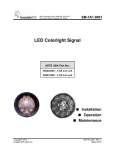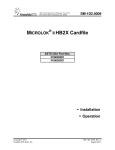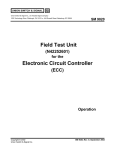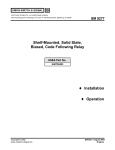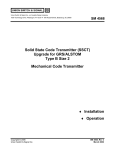Download Single and Double Rail - Ansaldo STS | Product Support
Transcript
SM 6087 1000 Technology Drive, Pittsburgh, PA 15219 645 Russell Street, Batesburg, SC 29006 Single and Double Rail Power Frequency Track Circuits THIS MANUAL SUPERSEDES SM-6087 DATED DECEMBER 1984 Description Operation Maintenance Copyright © 2012 Ansaldo STS USA, Inc. SM 6087, Rev. 0 March 1986 Notices Proprietary Notice This document and its contents are the property of Ansaldo STS USA, Inc. (formerly known as Union Switch & Signal Inc., and hereinafter referred to as "ASTS USA"). This document is furnished to you on the following conditions: 1.) That no proprietary or intellectual property right or interest of ASTS USA is given or waived in supplying this document and its contents to you; and, 2.) That this document and its contents are not to be used or treated in any manner inconsistent with the rights of ASTS USA, or to its detriment, and are not to be copied, reproduced, disclosed or transferred to others, or improperly disposed of without the prior written consent of ASTS USA. Important Notice ASTS USA constantly strives to improve our products and keep our customers apprised of changes in technology. Following the recommendations contained in the attached service manual will provide our customers with optimum operational reliability. The data contained herein purports solely to describe the product, and does not create any warranties. Within the scope of the attached manual, it is impossible to take into account every eventuality that may arise with technical equipment in service. Please consult an ASTS USA local sales representative in the event of any irregularities with our product. ASTS USA expressly disclaims liability resulting from any improper handling or use of our equipment, even if these instructions contain no specific indication in this respect. We strongly recommend that only approved ASTS USA spare parts are used as replacements. SM 6087, Rev. 0, March 1986, i Revision History Revision History Rev. 0 ii Date March 1986 Nature of Revision Initial Release SM 6087, Rev. 0, March 1986 Table of Contents Table of Contents 1. 2. 3. 4. 5. INTRODUCTION ............................................................................................................................... 1-1 1.1. Purpose..................................................................................................................................... 1-1 1.2. Description ................................................................................................................................ 1-1 1.3. Single Rail Track Circuits.......................................................................................................... 1-1 1.3.1. Track Transformer ........................................................................................................ 1-2 1.3.2. Relay Transformer ........................................................................................................ 1-2 1.3.3. Limiting Resistors ......................................................................................................... 1-3 1.3.4. Track Relay ................................................................................................................... 1-3 1.3.5. Fuses ............................................................................................................................ 1-3 1.3.6. Insulated Joints ............................................................................................................. 1-4 1.4. Double Rail Track Circuits ........................................................................................................ 1-4 1.4.1. Track Transformer ........................................................................................................ 1-5 1.4.2. Limiting Resistor ........................................................................................................... 1-5 1.4.3. Track Relay ................................................................................................................... 1-5 1.4.4. Fuse .............................................................................................................................. 1-5 1.4.5. Insulated Joints ............................................................................................................. 1-5 1.4.6. Lightning Arresters ........................................................................................................ 1-5 1.4.7. Impedance Bonds ......................................................................................................... 1-5 1.4.8. Miscellaneous ............................................................................................................... 1-6 TRACK CIRCUIT PARAMETERS..................................................................................................... 2-1 2.1. General ..................................................................................................................................... 2-1 2.2. Basic Considerations ................................................................................................................ 2-1 2.2.1. Source Voltage ............................................................................................................. 2-2 2.2.2. X and R Limiting Resistance......................................................................................... 2-2 2.2.3. Level Detection ............................................................................................................. 2-2 2.2.4. Relay Impedance .......................................................................................................... 2-2 2.2.5. Ballast Resistance ........................................................................................................ 2-3 2.2.6. Rail Impedance ............................................................................................................. 2-3 2.2.7. Insulated Joints ............................................................................................................. 2-3 MAINTENANCE ................................................................................................................................ 3-1 3.1. Preventive Maintenance ........................................................................................................... 3-1 3.1.1. Scheduled Maintenance ............................................................................................... 3-1 3.1.2. Track Circuit Adjustment Procedure ............................................................................. 3-2 3.2. Corrective Maintenance and Troubleshooting .......................................................................... 3-3 ADJUSTMENT TABLES ................................................................................................................... 4-1 RAIL TEAM AND TECHNICAL SUPPORT ...................................................................................... 5-1 SM 6087, Rev. 0, March 1986, iii Table of Contents List of Figures Figure 1-1. Typical Single Rail Track Circuit ............................................................................................. 1-2 Figure 1-2. Typical Double Rail track Circuit for DC Propulsion Territory ................................................ 1-4 Figure 2-1. Basic Considerations .............................................................................................................. 2-1 Figure 4-1. Typical Single Rail Track Circuit Adjustment Table ................................................................ 4-2 Figure 4-2. Typical Non-Coded AC Track Circuit Control, Double Rail Track Circuit Adjustment Table .................................................................................................................. 4-3 List of Tables Table 2-1. Track Circuit Parameters ...................................................................................................... 2-2 Table 3-1. Track and Relay Status......................................................................................................... 3-3 iv SM 6087, Rev. 0, March 1986 Introduction 1. INTRODUCTION 1.1. Purpose The purpose of a track circuit is to detect the presence of a train within the definite boundaries of a length of track and initiate indication and control signals. A track circuit may also be used to detect a broken rail and broken down insulated rail joints. 1.2. Description A track circuit may be defined as an electrical circuit of which the rails are a part. Single rail AC track circuits can be applied in railroad territory employing self-powered units (e.g., diesel powered), or in territory employing electrically powered units. In electrified territory, AC or DC propulsion power is delivered to the unit(s) traction motor(s) by a third rail or an overhead trolley wire, and by one of the running rails. This rail is generally called the common rail or the return rail. Since this rail must carry the traction return current, it does not have any insulated joints to define the track circuit. The track circuit is defined by placing the insulated joints in the other rail or the so called signal rail. An AC track circuit that employs insulated joints in the signal rail only is called a single rail AC track circuit. This circuit does use both rails to conduct the track signaling current. In electrified territory the common rail is therefore carrying both traction return current and track signaling current (see Figure 2-1). Where one of the rails cannot be dedicated to signaling purposes only due to heavy propulsion current, then the double rail track circuit can be used. The double rail track circuit is characterized by the insulated joints used in both the rails which are used to carry the propulsion current as well as the signal current. Another special feature is the impedance bond. 1.3. Single Rail Track Circuits A typical single rail track circuit is comprised of the following components and is shown in Figure 1-1: A. B. C. D. E. F. Track Transformer Relay Transformer Limiting Resistors Track Relay Fuses Insulated Joints SM 6087, Rev. 0, March 1986, 1-1 Introduction THIRD RAIL OR TROLLEY WIRE GENERATOR RETURN RAIL MOTOR F F SIGNAL RAIL E E C C A B E 115V AC* D 1F3.0001.00 115V AC* *MUST BE SAME SOURCE Figure 1-1. Typical Single Rail Track Circuit 1.3.1. Track Transformer The track transformer, as its name implies, is used to supply current to the rails. To minimize leakage of the track circuit current from rail-to-rail, a low track voltage is necessary; therefore, the track transformer is a step-down type. The secondary is usually tapped to accommodate the variables such as the type of relay, length of track circuit and minimum anticipated ballast conditions. 1.3.2. Relay Transformer Referring to Figure 1-1, it can be seen that DC propulsion current that leaves the third rail or trolley wire and passes through the motors of a train, divides between the return rail and the path afforded by the track circuit apparatus and the signal rail. In order to prevent any of this DC from passing through the relay, where it could cause undesirable magnetic saturation of the relay 1-2 SM 6087, Rev. 0, March 1986 Introduction structure, the relay is isolated from the DC path by transformer B. (If the propulsion current is small and the track circuit is short, thereby reducing the DC current in the signal rail, it may be possible to omit the relay transformer.) The relay transformer is designed to saturate when an excessive amount of DC current flows in it. This causes the relay to become decoupled from the track, thus protecting the relay against false pickup that could result from any AC ripple that the DC propulsion current might contain. 1.3.3. Limiting Resistors To prevent serious heat or burn up of the track transformer due to short circuit current when a train is on the track circuit, a limiting resistor is placed in series with the secondary of the track transformer. This resistor and another (C in Figure 1-1) placed in series with the primary of the relay transformer, when used, also limit the DC current in the transformer(s) when the track circuit is unoccupied. 1.3.4. Track Relay A single element or a double element relay may be used in an AC track circuit. A single element relay has to receive all its operating power from the track circuit. Since the basic track circuit exhibits high electrical losses, the less power transmitted over it, the better. To overcome the need for all the relay power to be supplied by the track circuit, a two element relay can be used. The two element relay is provided with two separate winding elements. One is connected to and receives power over the rails from the track transformer and is called the track element, while the other, called the local element, receives power from the same wayside source which feeds the track transformer. Now only a small amount of power needs to be supplied by the track circuit, with a larger amount of power being supplied to the local winding from the local power source. Both elements must be energized simultaneously for the relay to be picked-up. The local element of the track relay and the track transformer must be supplied from the same line of the wayside power source, and connected to insure proper phase relations between the relay track element and local element. The use of double element track relays also provides additional safety and reliability by preventing the relay in a given track circuit from being falsely energized by the track transformer of an adjoining track circuit in the event that an insulated joint (F in Figure 1-1) malfunctions and allows signaling current to pass from one circuit to the next. This broken down insulated joint protection is obtained when the instantaneous polarities of the track transformer secondaries of adjacent track circuits are staggered, so that signaling current being fed over a broken down joint will tend to drive the relay down instead of up. 1.3.5. Fuses A defective rail joint bond in the return rail would cause an increase in the return rail resistance with a corresponding increase in propulsion current in the track circuit apparatus. Also, under fault conditions, the full propulsion voltage could be impressed across the track circuit. Therefore; protective fuses (E in Figure 1-1) are placed in series with both the track and relay transformers. Fusing of single rail track circuits is the same whether the propulsion current is AC or DC. SM 6087, Rev. 0, March 1986, 1-3 Introduction 1.3.6. Insulated Joints Insulated joints (F in Figure 1-1) are used to define the boundary of a track circuit or to isolate adjacent track circuits. 1.4. Double Rail Track Circuits A typical double rail track circuit is comprised of the following components and is shown in Figure 1-2: A. B. C. D. E. F. G. Track Transformer Limiting Resistor Track Relay Fuse Insulated Joints Lightning Arresters Impedance Bonds E _ E _ + G G + G G _ + E E F F F F F F B A D 1F3.0002.00 115 VAC* C 115 VAC* * MUST BE SAME SOURCE Figure 1-2. Typical Double Rail track Circuit for DC Propulsion Territory 1-4 SM 6087, Rev. 0, March 1986 Introduction 1.4.1. Track Transformer The track transformer for a double rail track circuit is the same as for the single rail track circuit. 1.4.2. Limiting Resistor As in the single rail track circuit, a limiting resistor is needed in the secondary of the track transformer to limit the short circuit current when a train occupies the double rail track circuit. 1.4.3. Track Relay The same type of relay is used in the double rail track circuit as in the single rail circuit. As with the single rail track circuit, the local element of the track relay and the track transformer must be supplied from the same line of the wayside power source. 1.4.4. Fuse A double rail track circuit in DC propulsion territory is fused as shown in Figure 2-2. In AC propulsion territory, an additional fuse is added at the relay end of the track circuit. 1.4.5. Insulated Joints The same type of insulated joint is used in the double rail track circuit as in single rail circuit, except they are placed in both rails. This isolates adjacent track circuits from each other and with the addition of an impedance bond, characteristic of the double rail track circuit, allows both rails to be used to provide a return of the propulsion current from track circuit to track circuit back to the power source. 1.4.6. Lightning Arresters To limit the voltage impressed on any component of the track circuit and to minimize surge currents, suitable arresters should be used. Series arresters should be used between each track lead and ground. Shunt arresters should also be placed across the track leads to limit the voltage that might he developed across them. Two types of lightning arresters are available; low voltage, designed to break down above 50V (peak) and below 300V (peak), and high voltage, designed to break down above 500V (peak) and below 1200V (peak). 1.4.7. Impedance Bonds The impedance bond (G, Figure 2-2) is a feature that distinguishes the double rail from the single rail track circuit. It is called a "bond" because it is a low DC resistance connection between adjacent track circuits, and it is an "impedance bond" because it provides impedance to the flow of AC signaling current from one rail to the other of the track circuit across which it is connected. The impedance bond consists of a laminated core upon which are wound two heavy copper windings wound in opposite directions so that the DC propulsion current in one winding is in opposition to the current in the other winding, thereby producing no net flux in the iron core. The AC track circuit voltage is applied to the two windings in series, but not in opposition, so the full impedance of both windings is present to the track circuit signal. Adjacent impedance bonds are connected across their middle or neutral connection which serves to carry the propulsion current from one track circuit to the other. With perfect bonding of the rails in a double rail track circuit, the resistance of both rails of the track circuit should be the same, hence the propulsion current will divide equally between the SM 6087, Rev. 0, March 1986, 1-5 Introduction rails and the current in the two windings of the bond will be equal and no DC flux will be produced in the core. This perfect balance cannot always be assured due to loose or broken rail bonds or a dirty rail in which case the unbalanced current could magnetize the core of the impedance bond, with a resultant lowering of the permeability of the core and creating a serious leakage of AC signaling current through the bond. To prevent this, DC bonds are designed to handle up to a 12% unbalance without more than 10% decrease in impedance of the bond. 1.4.8. Miscellaneous Due to the many various applications of the single and double rail track circuits, deviations from the basic track circuit become necessary. Where an Audio Frequency Overlay (AFO) is used in conjunction with a power frequency (PF) track circuit, an inductor/capacitor (LC) filter is used in series with the primary of the Track Transformer to prevent the feed end of the track circuit from presenting a low impedance load to the AF frequencies. Another case is where the Track Relay cannot be situated close enough to the tracks to meet the specified maximum lead resistance, then a step-up transformer is used to raise the track voltage to carry the signal current over the long distance to the Track Relay case thereby reducing line losses and then to a step-down transformer to lower the voltage back down to drive the Track Relay. 1-6 SM 6087, Rev. 0, March 1986 Track Circuit Parameters 2. TRACK CIRCUIT PARAMETERS 2.1. General Track circuits come in many different types and configurations such as the conventional steady DC track, the coded track, single and double element ac, single rail, double rail, and the jointless circuits. All these different types of track circuits must work under the same basic considerations (Section 2.2), although to different values. 2.2. Basic Considerations Referring to Figure 2-1, there are seven basic considerations: 1. Es - Source Voltage 2. X and R - Limiting Resistance 3. TR - Level Detection 4. TR - Relay Impedance 5. B - Ballast Resistance 6. Z - Rail Impedance 7. J - Insulated Joints Z Z B J J X R Es 115V AC 1f3.0003.00 TR 115V AC Figure 2-1. Basic Considerations SM 6087, Rev. 0, March 1986, 2-1 Track Circuit Parameters 2.2.1. Source Voltage Concerning the source voltage, the values of interest are the minimum voltage at which the track circuit must operate at minimum ballast conditions, and the maximum voltage at which the track relay must release with a specified shunt value within the circuit at dry ballast. The smaller the voltage variation, the longer the track circuit that can be safely worked for a given minimum ballast or conversely, the lower the minimum ballast that can be safely worked for a given track circuit length. This points out the need for good source voltage regulation. 2.2.2. X and R Limiting Resistance Of concern here is the minimum amount of resistance that can be put into the circuit and still protect the transformer against a short circuit, while assuring that the circuit releases with a shunt within the circuit at maximum voltage at dry ballast. Also of concern is the maximum resistance that can safely be put in the circuit and still have it work properly at the minimum ballast and minimum source voltage. 2.2.3. Level Detection Track relays require a certain amount of current for proper operation and this current is identified as the working current. It is also required that the current fall to a certain level before the relay releases. This level is identified as the release current. The ratio between the release current and the working current is identified as level detection. Engineering studies have shown that longer track circuits for a given ballast can be worked by using a relay with a higher percentage level detection. Conversely it can be said that a given length track circuit can be worked to a lower ballast; hence the ballast maintenance program is not as critical. Typical relay level detection ranges from 45% to 70%. It is not practical to attempt to achieve and maintain near 100% level detection when considering such things as temperature variations, component, assembly, and aging tolerances. 2.2.4. Relay Impedance The selection of the relay coil impedance also influences the maximum track circuit length possible for a given minimum ballast, or the minimum allowable ballast for a given track circuit length. Typical examples of track circuit parameters with different relay coil impedances are shown in Table 2-1. Table 2-1. Track Circuit Parameters Coil Impedance in Ohms Minimum Ballast/M Feet for 1210-Foot Circuit Maximum Track Circuit Length with 1.0 Ohm Shunt 2.5 ohms/M Feet AC Ballast 0.5 1.2 1.8 2.5 6.2 Ohms 3.2 Ohms 2.7 Ohms 2.5 Ohms 510 Feet 975 Feet 1140 Feet 1210 Feet 2-2 SM 6087, Rev. 0, March 1986 Track Circuit Parameters 2.2.5. Ballast Resistance Ballast resistance is the resistance of the ballast, ties, etc., to leakage of current from one rail of a circuit to the other. This resistance varies with type of ballast, moisture, salt content, proximity to the rails, drainage, and tie and spike conditions. When the ballast is frozen, it has nearly infinite resistance. When ties are in good condition and the ballast is not in contact with the rails, the minimum DC ballast will be about one or two ohms per thousand feet, and in some cases even higher. On the one hand with clean ballast, the resistance may be 5 to 10 ohms per thousand feet, and in rare cases even higher. On the other hand, cracked and dirt filled ties with dirty ballast in contact with the rails may cause the minimum resistance to be 0.5 ohm per thousand feet or less. Actually, the ballast does not act like ordinary resistance but exhibits properties similar to capacitance in combination with resistance. Thus the AC ballast resistance is usually lower than the DC resistance, the ratio depending on the type of ballast. Usually the AC/DC ballast ratio is about 2/3. It is obviously important that the ballast maintenance program be able to maintain the stated minimum ballast figures, or in consequence the signal department will be spending a great amount of time in the field resetting track circuits during bad ballast conditions. 2.2.6. Rail Impedance The rails of a track circuit have both resistance and inductance. The DC resistance varies with the type of bonding used, and the weight and length of tie rail. The effective AC resistance of a steel rail, at power frequencies, is from 3 to 5 times the actual DC resistance, due to the skin effect. A further increase in the impedance of the rails in AC track circuits is caused by inductive reactance. 2.2.7. Insulated Joints With insulated joints in both rails, there is sharp circuit definition and no power loss beyond the insulated joints. When insulated joints are used in only one rail, as in a single rail circuit, the number of insulated joints is reduced to one-half, but also the minimum ballast resistance is half of what it is with a double rail circuit. This is due to the rail that is not insulated being exposed for the entire length of the railroad, and it tends to approach ground potential. This has the effect of moving the return rail closer to the signal rail, thus decreasing the ballast resistance between them. SM 6087, Rev. 0, March 1986, 2-3 Track Circuit Parameters 2-4 SM 6087, Rev. 0, March 1986 Maintenance 3. MAINTENANCE 3.1. Preventive Maintenance WARNING Inadvertent connection between the third rail and signal rail can cause high voltage to be present on the signal rail and track leads, and inside the signal case containing the equipment of that track circuit. When maintaining this equipment, make certain to follow standard safety procedures for high voltage circuits. Otherwise, personal injury may result. During periodic inspection of the territory, track circuits should be inspected and maintained to keep the circuits operating at optimum performance. Bonding and connections should be inspected and maintained to insure a low resistance. Switches, circuit controllers, frogs, and fouling circuits must be maintained to avoid breaks or high resistances. Insulated rail joints, wire and cable, lightning arresters, pipe lines, switch rods, and gauge plates should not be overlooked. Also the condition of the ties and ballast should be maintained, along with the transformers, fuses, resistors, and relays. 3.1.1. Scheduled Maintenance It is suggested that periodic inspections and tests be performed to assure optimum operating performance. The following items should be inspected and tested as follows: A. Check the track circuit "Es volts" and "TR current" every three months and compare the data against the previously calibrated values for approximately the same ballast conditions. B. Every two years, visually inspect the vital relays for foreign matter, worn or damaged parts, burnt contacts, and check that the covers and seals are intact. Every two years, test the relay calibration in accordance with the appropriate Service Manual. Any relay that fails to meet the requirements of these specified tests should not he restored to service until the relay is operating within specified limits. C. Visually inspect track circuit wiring and connections at three month intervals. Every three months, verify that a shunt applied to the rails of a turnout or crossover will cause the main track circuit relay to release. D. Test data should be maintained in sequential order so that slow degradation will be evident. This will facilitate failure prediction as well as failure prevention. SM 6087, Rev. 0, March 1986, 3-1 Maintenance 3.1.2. Track Circuit Adjustment Procedure Before attempting to adjust a track circuit, insure that no propulsion current is being drawn through the rails of the track circuit to be adjusted and that the ballast resistance is not less than as specified on specific track circuit table. 1. Select the track transformer secondary taps that will provide as nearly as possible the voltage Es specified by the adjustment table supplied for the track circuit. (See typical tables in Figure 4-1 and Figure 4-2). Adjust for the minimum ballast resistance anticipated. 2. The relay vane should be in contact with the front roller. Depending on ballast and line voltage conditions, the roller may or may not be pushed part way up its guide. (When ballast resistance and line voltage are at their minimum values, the vane should just meet the roller.) If the vane does not rotate far enough to make contact with the roller, determine the reason and correct any problem before proceeding. If the problem proves to be that the ballast resistance is lower than the anticipated minimum value, readjust the track transformer secondary voltage in accordance with the adjustment table. 3. Apply a shunt of the maximum specified resistance on the rails at the feed end of the track circuit, Observe that the track relay drops (deenergizes). Remove the shunt and observe that the track relay picks (energizes). 4. Apply the shunt on the rails of the relay end of the track circuit and observe that the track relay drops. Remove the shunt and observe that the track relay picks. 5. Shunt, one at a time, each track circuit extremity of any turn-out or crossover and observe that the track relay drops every time the shunt is applied. 6. Check for proper phasing of the track circuit by jumpering the insulated joints (within and at the extremities of the track circuit). A picked track relay may or may not drop, but a released relay (track shunted) must not pick. 7. Deenergize the feed end of the track circuit and observe that the track relay deenergizes. 3-2 SM 6087, Rev. 0, March 1986 Maintenance 3.2. Corrective Maintenance and Troubleshooting The track circuit is simple to troubleshoot due to its few components and a relay load that has only two major malfunction symptoms: (1) Its contacts can be always closed, and (2) its contacts can be always open. Table 4-1 lists the track and relay status, with the possible item failure and mode. Table 3-1. Track and Relay Status Track Status Track Relay Status Possible Item Failure Occupied Pick None Occupied Pick Track Resistor Occupied Pick Relay Resistor Not Occupied Not Occupied Not Occupied Drop Drop Drop All Fuses Track Transformer Track Transformer Not Occupied Drop Track Transformer Not Occupied Not Occupied Not Occupied Not Occupied Not Occupied Not Occupied Not Occupied Not Occupied Not Occupied Not Occupied Not Occupied Not Occupied Not Occupied Drop Drop Drop Drop Drop Drop Drop Drop Drop Drop Drop Drop Drop Track Transformer Track Transformer Track Resistor All Lighting Arresters Connecting Wires Connecting Wires Track Lead Track Relay Track Relay Relay Transformer Relay Transformer Relay Transformer Relay Transformer Not Occupied Drop Relay Resistor Not Occupied Not Occupied Not Occupied Not Occupied Not Occupied Drop Drop Drop Drop Drop Relay Resistor Track Rail Connection Relay Rail Connection Rail Bond(s) Insulated Joint SM 6087, Rev. 0, March 1986, Item Failure Mode Poor Shunting Conditions Improper Tap Adjustment Improper Tap Adjustment Open Open Primary Coil Open Secondary Coil Wrong Secondary Voltage Shorted Turns Pri./Sec. Short Resistance Increase Shorted Open Shorted Together Open Open Coil Shorted Coil Open Primary Coil Open Secondary Coil Shorted Turns Pri./Sec. Short Improper Tap Adjustment Resistance Increase Open Open Broken Broken Down Insulation 3-3 Maintenance 3-4 SM 6087, Rev. 0, March 1986 Adjustment Tables 4. ADJUSTMENT TABLES Figure 4-1 and Figure 4-2 are track circuit adjustment tables and parts list for a typical track circuit of the single and double rail type. SM 6087, Rev. 0, March 1986, 4-1 Adjustment Tables R TR = PV-250 N342555-003, 2.5 66 Ohms, 2F-2B Std. L. V. Full Stroke = 0.327 Amp. T1 = W-400, N451428-0101 T2 = Reactive Transformer, N393992 (1 to 1 turn ratio) R = 5 Ohm Adjustable Resistor, N451140-0102, Adjusted for 5 Ohms 60 Hz Rail Impedance = 0.2 69 Ohm/M Ft. Minimum Resistance to Shunt Track Relay = 0.25 Ohm Maximum Line Voltage regulation = 10% Table based on total lead resistances of 0.08 Ohm from T2 to TR and 0.5 Ohm from rails to T1 or T2 R ES T2 1F3.0004.00 T1 115V 60 TR Minimum AC Ballast Adjustment Table Track Circuit Length (Feet) 700 600 500 400 300 200 100 50 Minimum AC Ballast (Ohms/M FT.) ES (Volts) Dry Current Amperes 3.30 2.80 2.35 1.85 1.38 0.92 0.46 0.23 18.0 18.0 18.0 18.0 18.0 18.0 18.0 18.0 1.09 1.09 1.10 1.10 1.10 1.10 1.10 1.10 115V 60 Minimum AC Ballast of 3.0 Ohms/M. Ft. Adjustment Table Track Circuit Length (Feet) 600 500 400 300 200 100 50 ES (Volts) Dry Current Amperes 17.4 15.7 14.0 12.4 10.7 9.1 8.3 1.06 0.96 0.85 0.76 0.65 0.56 0.51 Minimum AC Ballast of 5.0 Ohms/M. Ft. Adjustment Table Track Circuit Length (Feet) 1000 900 800 700 600 500 400 300 200 100 50 ES (Volts) Dry Current Amperes 17.6 16.5 15.5 14.4 13.4 12.4 11.4 10.4 9.4 8.5 8.0 1.07 1.00 0.94 0.88 0.81 0.75 0.69 0.63 0.57 0.52 0.49 Figure 4-1. Typical Single Rail Track Circuit Adjustment Table 4-2 SM 6087, Rev. 0, March 1986 Adjustment Tables RX 1F3.0005.00 ES TR = PV - 250 Spec. 5174 (Track coils in multiple) Relay Impedance 0.175 70 Ohm, Min. Working 1.5 Amperes Track Transformer similar to Style W-21, Pc. 297709 25 Cycle Rail Impedance 0.1 Ohm/M ft. At 0.5 P.F. 60 Impedance Bond 0.2 Ohm at 0.2 P.F. 78.5 Broken Rail Protection (Cross-bonding at every other location, but in no case less than 5000 ft. separation). Min. Resistance to Shunt Track Relay 0.06 Ohm. Table based on total lead resistance (including track leads and case wiring) of 0.1 Ohm at each end of track circuit. Maximum line voltage regulation 10% R X = 0.3 Ohm (SR34 - A - 13) 25 TR Minimum AC Ballast Adjustment Table Track Circuit Length (Feet) 6,000 5,500 5,000 4,500 4,000 3,500 3,000 2,500 2,000 1,500 1,000 500 NOTE: TR Dry Amps. Figures calculated assuming ammeter in series with relay. Hence in some cases dry amps. Figure is less than relay working current. Minimum AC Ballast (Ohms/M FT.) ES (Volts) Maximum TR Amps Dry 3.44 3.02 2.62 2.26 2.00 1.94 1.89 1.87 1.11 1.01 0.94 0.88 8.75 8.21 7.66 7.13 6.60 5.85 5.15 4.50 4.20 3.62 3.07 2.57 1.84 1.83 1.82 1.80 1.78 1.71 1.64 1.56 1.61 1.55 1.46 1.39 Minimum AC Ballast of 2.0 Ohms/M. Ft. Adjustment Table Track Circuit Length (Feet) 4,000 3,500 3,000 2,500 2,000 1,500 1,000 500 ES (Volts) Maximum TR Amps Dry 6.60 5.78 5.08 4.47 3.92 3.43 2.97 2.52 1.78 1.69 1.61 1.56 1.50 1.45 1.42 1.38 Minimum AC Ballast of 3.3 Ohms/M. Ft. Adjustment Table Track Circuit Length (Feet) 5,500 5,000 4,500 4,000 3,500 3,000 2,500 2,000 1,500 1,000 500 ES (Volts) Maximum TR Amps Dry 8.03 7.25 6.58 5.93 5.34 4.81 4.30 3.81 3.36 2.95 2.50 1.79 1.72 1.66 1.60 1.56 1.52 1.48 1.46 1.43 1.41 1.38 Figure 4-2. Typical Non-Coded AC Track Circuit Control, Double Rail Track Circuit Adjustment Table SM 6087, Rev. 0, March 1986, 4-3 Adjustment Tables 4-4 SM 6087, Rev. 0, March 1986 RAIL Team and Technical Support 5. RAIL TEAM AND TECHNICAL SUPPORT The Rapid Action Information Link Team (RAIL Team) is a group of experienced product and application engineers ready to assist you to resolve any technical issues concerning this product. Contact the RAIL Team in the United States at 1-800-652-7276 or by e-mail at [email protected]. SM 6087, Rev. 0, March 1986 5-1 RAIL Team and Technical Support End of Manual 5-2 SM 6087, Rev. 0, March 1986





























